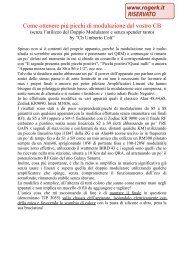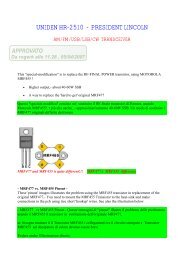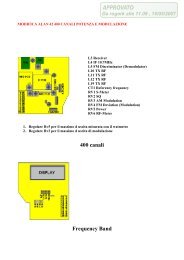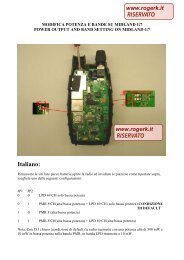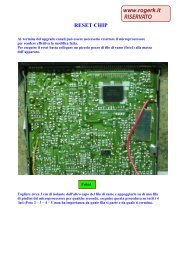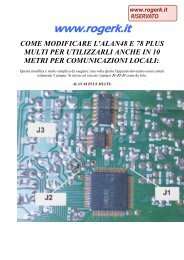Modifications for the ICOM - RogerK
Modifications for the ICOM - RogerK
Modifications for the ICOM - RogerK
- No tags were found...
You also want an ePaper? Increase the reach of your titles
YUMPU automatically turns print PDFs into web optimized ePapers that Google loves.
28-01-2002(IC-751) <strong>ICOM</strong> IC-751 Dual RAM back-up Battery ModificationAuthor: Stuart - KI6QP - stuart@valontechnology.com.MODIFICATION.NETThis modification adds two lithium cells and diode steering to provide future fail-safe cell replacement. You will have to build alittle breadboard with a couple of Schottky diodes and battery holders but <strong>the</strong> cost is way less than <strong>the</strong> shipping charge to sendyour rig back.Stuart Rumleyki6qp20 January 2002The <strong>ICOM</strong> IC-751 is my all time favorite radio. I haven't personally owned a lot of radios but I have worked on quite a fewincluding Collins, Drake, Yaesu, Kenwood, Alinco, Heathkit, Icom, and many o<strong>the</strong>rs.What makes <strong>the</strong> IC-751 a nice radio <strong>for</strong> me is its clean, mostly discrete design with only a few high integration integratedcircuits. It has a robust receiver with high input IP3 and well balanced gain. The 751 uses real crystal filters and doesn't rely onany phony-baloney last-IF-stage-in-radio-pseudo DSP <strong>for</strong> selectivity.The front panel is intuitive and well laid out with a real meter, nothing I hate more than and LCD or plasm meter. There are realmedium sized knows and push-button switches designed <strong>for</strong> real people's hands and fingers that make operating this radio a joy.The transmitter is also an excellent design with separate, discrete and robust power amplifier section.The 751 does not include an antenna tuner which I think to some degree is an advantage. For antennas that are not wellmatched, an external antenna tuner must be used. Generally, external antenna tuners are more efficient and always morereliable than internal antenna tuners and are very simple to maintain.RAM battery scheme is a bit dubious. The original design requires <strong>the</strong> owner to send <strong>the</strong> radio back to <strong>ICOM</strong> every decade or soand have <strong>the</strong> lithium cell replaced. Failure to do so has left a number of owners with a brain dead rig and a conviction to neverby ano<strong>the</strong>r <strong>ICOM</strong> radio again.Clearly it was a manufacturing expedience to use a battery backed SRAM instead of a more expensive EPROM <strong>for</strong> <strong>the</strong> programcode plus an SRAM <strong>for</strong> <strong>the</strong> user memory. One can imagine that <strong>the</strong>y could have socketed <strong>the</strong> lithium cell so that user couldreplace it while <strong>the</strong> radio was powered on. I suspect this idea was discarded because of possible product liability issues withhaving <strong>the</strong> operator change <strong>the</strong> cell with <strong>the</strong> power on.This modification adds a small, home brew breadboard containing two replaceable 20mm lithium cells. Each cell can be replacedone at a time so that one cell is always powering <strong>the</strong> RAM. In addition, this modification leaves <strong>the</strong> original cell in place whichgreatly reduces <strong>the</strong> possibility of accidentally clearing <strong>the</strong> memory.Modification instructionsThis is a pretty simple modification and I think considerably safer to per<strong>for</strong>m than <strong>the</strong> battery replacement method that Icomrecommends. However, you do have to use above average care due to <strong>the</strong> risk of losing <strong>the</strong> program memory. If this happens<strong>the</strong> radio will not be able to tune <strong>the</strong> syn<strong>the</strong>sizer and you will have to return <strong>the</strong> RAM board to <strong>ICOM</strong> <strong>for</strong> reprogramming.You will not need any additional power supplies or batteries to power <strong>the</strong> RAM board during this procedure. The existing RAMboard cell will keep <strong>the</strong> memory alive during this operation. You should be using a grounded soldering iron, however, to minimize<strong>the</strong> risk of static discharge altering <strong>the</strong> memory.You will be working with ra<strong>the</strong>r close spaced traces on <strong>the</strong> RAM board and <strong>the</strong> only precaution you need to be aware of is to notallow <strong>the</strong> battery board leads, soldering iron, or tools to short <strong>the</strong> RAM board cell.Step 1: Assemble <strong>the</strong> dual battery board as shown below and in <strong>the</strong> schematic shown in pdf. Use approximately 10 inches oftwisted black and red AWG 26 hook-up wire to make <strong>the</strong> connection to <strong>the</strong> RAM board. Prepare <strong>the</strong> RAM board ends of <strong>the</strong> blackand red wire by stripping back about 1/8" of insulation an tin <strong>the</strong> leads.Note that <strong>the</strong> board has two 2mm mounting holes spaced approximately 35mm. This will facilitate mounting <strong>the</strong> board in <strong>the</strong> 751chassis on <strong>the</strong> voice module mounting holes.Test <strong>the</strong> completed board with a VOM to ensure that <strong>the</strong> diodes have be correctly installed.




